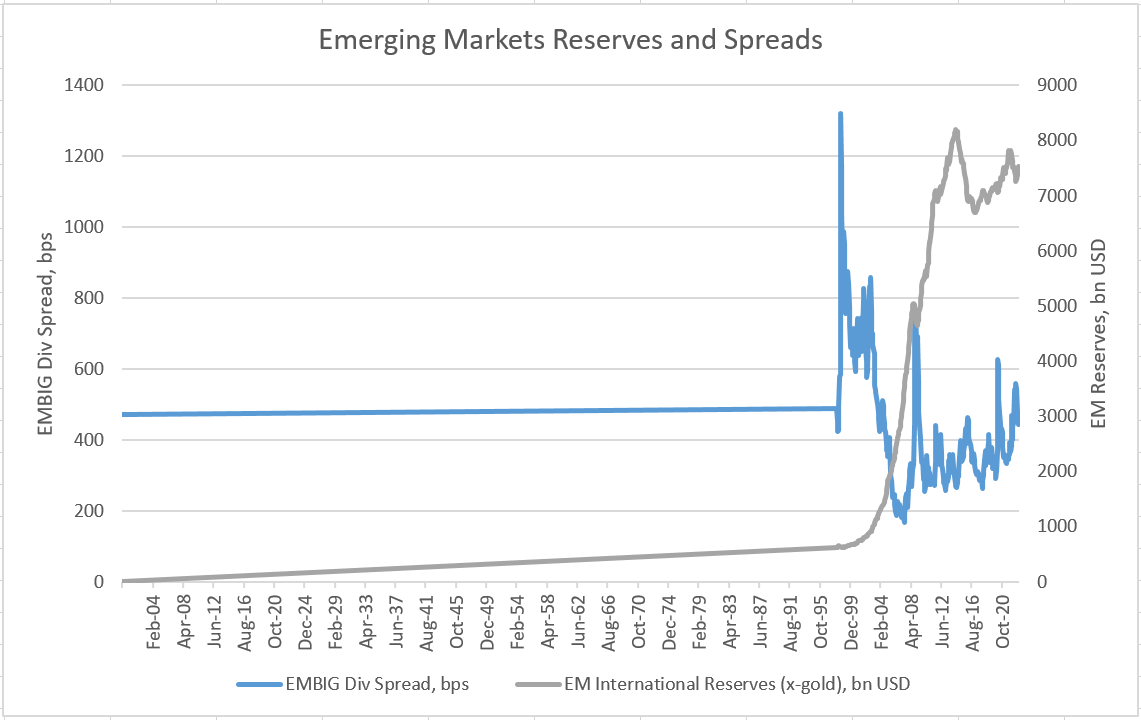FT, EM FX, and A Pinch of Salt
15 February 2023
Read Time 2 MIN
EM FX Devaluations
An FT article caught our attention this morning – but it’s not the one about the sustainability of Japan’s central bank government bond purchases and potential changes in the yield curve control mechanism (YCC) under the new governor (albeit this might have very serious implications for global Fixed Income, especially Investment Grade instruments with their super-tight spreads). “Our” article talks about “a spate” and “a further slew” of emerging markets (EM) FX devaluations caused by the strong U.S. Dollar. We are not sure how well this characterizes EM, especially in light of strong performance of many EM currencies last year or a dramatic repricing lower of Asian interest rates. Further, letting currencies go while accelerating structural reforms and engaging multilateral financial support is probably the best thing that can happen to developing economies from the longer-term perspective. This is the lesson learned by their predecessors – many of whom are now “EM Graduates” - in the wake of the 1997/98 global financial crisis. Egypt is not doing this – yet - and therefore still strikes us as vulnerable to such episodes - it’s really a “classic” setup including the part about learning the hard way.
EM Structural Adjustment
Using FX as a shock-absorber – while relying on interest rates as the primary policy instrument to target inflation – helps to initiate a “textbook” adjustment of the current account balance (less imports and more competitive exports). With fewer FX interventions, this is the fastest way to start rebuilding the international reserves. Over time, the accumulation of reserves and a stronger structural/institutional backdrop should lead to a major decline in sovereign spreads, limiting the extent of potential “flare-ups” in the future. The chart below demonstrates all these points very well (higher reserves/tighter spreads/lower peaks). Many EMs are now net sovereign creditors in U.S. dollars!
EM FX And U.S. Dollar
EMs that used their past devaluation experiences wisely – reforms, accumulation of reserves, inflation-targeting – are now less tied up to the U.S. Dollar cycle. The Brazilian real, the Mexican peso, the Peruvian sol, and the Chilean peso ended up stronger vs. the U.S. Dollar last year. The final point here is that there are different ways to get exposure to emerging markets these days. For example, we don’t like Brazil’s local market currently (due to policy noise), so we just don’t own it…but the current environment can still be positive for Brazilian credits that pay in real and earn in U.S. Dollar (for example). Stay tuned!
Chart at a Glance: EM Reserves vs. Sovereign Spreads in Different Regimes

Source: Bloomberg LP.
DEFINICIONES Y DIVULGACIONES IMPORTANTES
Este material solo puede utilizarse fuera de los Estados Unidos.
Esto no es una oferta de compra o venta, ni una recomendación de ninguna oferta de compra o venta de ninguno de los valores mencionados. Las tenencias del Fondo variarán. Para ver una lista completa de las tenencias de VanEck Mutual Funds y los ETF de VanEck, visite nuestro sitio web www.vaneck.com.
La información presentada no implica la prestación de asesoramiento personalizado de inversión, financiero, legal o fiscal. Algunas de las afirmaciones contenidas en este documento pueden constituir proyecciones, previsiones y otras declaraciones prospectivas, pero no reflejan resultados reales. La información provista por fuentes de terceros se considera fiable, no ha sido verificada de forma independiente para comprobar su exactitud o integridad y no puede garantizarse. Todas las opiniones, proyecciones, previsiones y declaraciones prospectivas presentadas en este documento son válidas a la fecha de esta comunicación y están sujetas a cambios sin previo aviso. La información aquí contenida representa la opinión del autor o autores, pero no necesariamente la de VanEck.
Las opiniones incluidas en este documento no deben tomarse como consejos o recomendaciones para comprar o vender ninguna inversión en ninguna jurisdicción. Tampoco constituyen un compromiso por parte de Van Eck Associates Corporation o sus subsidiarias de participar en ninguna transacción con ninguna de las empresas mencionadas en este documento. Este contenido se publica en Estados Unidos. Los inversores están sujetos a los valores y las regulaciones impositivas de sus jurisdicciones correspondientes que no se mencionen en este documento.
Toda inversión está sujeta a riesgos, lo cuál incluye la posible pérdida del dinero invertido. Como ocurre con cualquier estrategia de inversión, no hay garantía de que se cumplan los objetivos de inversión y los inversores pueden perder dinero. La diversificación no asegura un beneficio ni protege contra una posible pérdida en un mercado en declive. El rendimiento previo no garantiza resultados futuros.